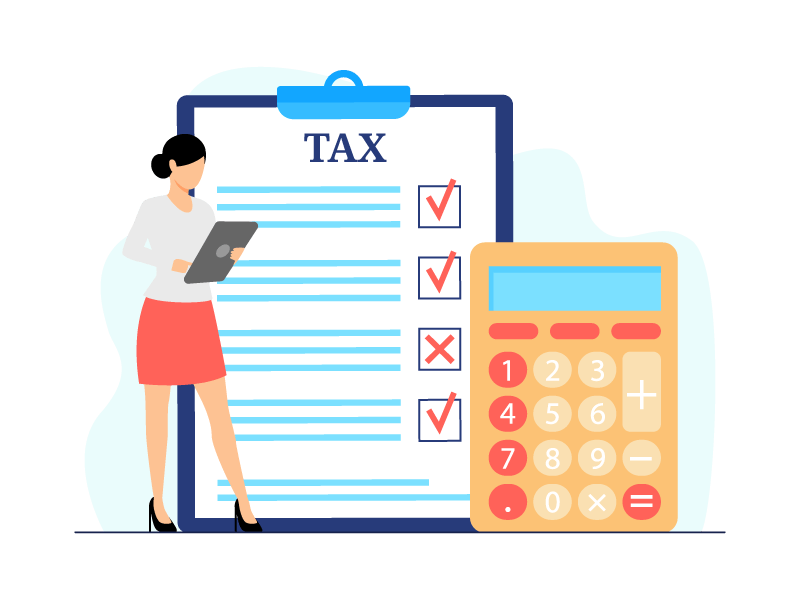Comparing Payroll Tax vs Income Tax as an Essential Part of Employee's Salary

Table of Contents
Are you a small business that calculates the payroll and tax by hand? When an employee waits for his salary but doesn’t receive it accordingly, the employer might be cursed because payment and tax are something that can create panic, whatever method an employer uses. Like payroll, tax withholding is also an essential area for an employer. As the total tax calculated can be bifurcated into two categories, it is mandatory to understand the difference between Payroll Tax vs Income Tax. The employer can even avoid salary offence along with ensuring the satisfaction of the employees.
If you are a small business, calculating tax by hand may be paralyzing, but again you don’t have to be. Whether you use software or not, it is better to take in the knowledge. Payroll Tax vs Income Tax differs a lot based on calculation. Here are the details of the same.
What are Payroll Taxes?
Payroll tax is a fixed rate that you withhold from the salary in the name of the tax deduction for employee security purposes. Under this scheme, employees and employers are responsible for contributing to the funds.
This tax amount is directly deducted from the employee’s payment when counting the salary. Though deducted in small percentages, such taxes help cover the employees’ medical and social security from the central government. Social and medical security include retirement benefits, disability, hospital care, and medicines.
After deducting the applicable taxes from the salary, the employer sends them to the government fund, which will add up and can be claimed by the employee when needed. This way, employers are liable for the security of their valuable assets.
Though the tax applies to all employees who can be covered by social and medical security, they are not mandated to sign under the terms and use the benefits.

What are the Different Types of Payroll Taxes?
Payroll tax can be bifurcated into three categories of different taxes, all of them providing benefits to the employee on the subject of social and medical security.
1. Provident Fund
Enacted by the government of India, The Employees’ Provident Fund & Miscellaneous Provisions Act, 1952 covers the whole of India exclusive of Jammu and Kashmir. This act ensures welfare benefits and social security after retirement to the employees who are a part of the fund.
This fund is organized by the Employees’ Provident Fund Organization under which both employee and employer contributions to the fund developed for the employees. Moreover, the employees are also benefited from the interest rate generated in the PF account.
The act is applicable to the factories and shops with at least 20 individuals employed. Any employee inclusive of the one employed through a contract under the condition of 3 months of employment without any break or 60 days of work, can be covered under the scheme.
Both employee and employer contribute equally, and the fund is divided into the Employees’ Provident Fund and Employees’ Pension Scheme.
| Employee’s Contributions | Employer’s Contributions | |
|---|---|---|
| Employees’ Provident Fund | 12% | 3.67% |
| Employees’ Pension Scheme | 0 | 8.33% |
| Total contribution | 12% | 12% |
These contributions are deducted as payroll tax from the gross wages of an employee and are filed to the EPF organization till 15 of the month. Breaching the act may call for an imprisonment of 3 years and a fine of 10,000 ₹.
Despite EPF, the employees can be a part of other similar schemes like:
- SPF – Statutory Provident Fund only covers the individuals employed with the Government and the Semi-government organizations.
- UPF – Unrecognized Provident Fund being a non-government approved fund initiated by the employers and employees of an organization.
- PPF – Public Provident Fund protects every Indian citizen as a part of a tax-saving option.
2. Employees’ State Insurance
Employees’ State Insurance is a fund managed by the ESI Corporation under the coverage of the Employees’ State Insurance Act, 1948. It is a self-financing health security scheme ensuring sickness, maternity, disablement, funeral, rehabilitation, and injuries of an employee. Just like the PF, ESI also takes in the contributions of both employee and employer. The amount contributed by an employee is deducted from his own salary. These contributions are:
| Contributions | % of Income |
|---|---|
| Employees’ contribution | 0.75 |
| Employer’s contribution | 3.25 |
Employees with the wage limit of 21,000 ₹ are covered under this scheme, and the contributions are deducted from the salary accordingly. This deduction is termed as payroll tax.
3. Gratuity
A type of retirement benefit, the Payment of Gratuity, 1972, offers employee benefits and incentives at the time of resignation or retirement from the organization. This act covers the employees working in mines, factories, shops, private sectors, railways, and oilfields, but not the employees with the apprentice and civil services.
For the payment of gratuity, the employer deducts a certain amount of wage from the monthly earnings and collects them till the time of demand. Another regulation is employees completing at least five years with the same organization are allowed to ask for gratuity.
The organization is mandated to approve gratuity in the case of disablement or death of an employee despite pending five employment years. The amount offered as gratuity is formulated based on the last received payment and of course the years of employment.
Gratuity = Total years of employment * last received salary * 15/26
What are Income Taxes?
Income tax refers to the tax submission responsibility of the employee that is to be submitted as subjected to central and state laws. This tax deducted is called Tax Deducted at Source (TDS). Income tax helps the government balance the economy and support the development of the nation.
Unlike payroll taxes, the income tax rate is not fixed; it increases with the increase in the income of an employee. Plus, Income tax is not divided into further categories. It is calculated based on the salary of an individual employee.
With the financial budget released every year, the income tax rates/ percentages may be renewed. This is not a regular phenomenon but to compensate for the increase in inflation; the tax percentages are changed.
The details of the tax deducted and the gross and net salary of the employee received are quoted in Form-16 issued under section 203 of the Income Tax Act, that a company should offer to the employee at the time of tax deduction.
In the assessment year 2022-23, the Income tax rates applicable for salaried individuals categorized below the age of 60 years as per existing and new regime are:
| Existing Tax Regime | New Tax Regime u/s 115BAC | ||
|---|---|---|---|
| Income Tax Slabs | Tax Rate | Income Tax Slabs | Tax Rate |
| Up to ₹2,50,000 | Nil | Up to ₹2,50,000 | Nil |
| ₹2,50,001 – ₹5,00,000 | 5% above ₹2,50,000 | ₹2,50,001 – ₹5,00,000 | 5% above ₹2,50,000 |
| ₹5,00,001 – ₹10,00,000 | ₹12,500 + 20% above ₹5,00,000 | ₹5,00,001 – ₹7,50,000 | ₹12,500 + 10% above ₹5,00,000 |
| Above ₹10,00,000 | ₹1,12,500 + 30% above ₹10,00,000 | ₹7,50,001 – ₹10,00,000 | ₹37,500 + 15% above ₹7,50,000 |
| ₹10,00,001 – ₹12,50,000 | ₹75,000 + 20% above ₹10,00,000 | ||
| ₹12,50,001 – ₹15,00,000 | ₹1,25,000 + 25% above ₹12,50,000 | ||
| Above ₹15,00,000 | ₹1,87,500 + 30% above ₹15,00,000 | ||
If you want to check the tax slabs and tax rates for salaried individuals falling under the categories of more than 60 years are mentioned in the income tax website.
This income tax is a part of the economy of the country contributed solely by the employee. However, apart from the contributions to the economy, the employee can file IT returns as a motive to receive the submitted amount in the form of TDS. For this, the employee needs to submit the Salary payslips and Form-16.

Why is Comparing Payroll Tax v/s Income Tax essential?
As we have noticed that both Payroll Tax and Income Tax are far apart from each other, the comparison of Payroll Tax vs Income Tax is also essential as they both form a significant part of an employee’s salary.
When you consider payroll tax, both employee and employer are mandated to contribute to the funds that help employees when needed. Both donate the same amount to the trusts. While contrary to this, under the Income tax, the employees are only required to contribute to balance the economic condition of the nation. However, they can recover the same amount through IT return filing at the end of the financial year.
Also, the Payroll tax is essential to cover the medical and social safety of the employees. In comparison, TDS is not directly beneficial for the employees. TDS amount is used for developing the nation by enhancing the infrastructure, roads, etc.
What things to Consider While Understanding the Difference Between Payroll and Income Tax?
Like payroll, deducting an accurate amount of taxes is also essential for employers. Salary and tax calculation and processing include legislative rules which no one must breach. Thus understanding the difference between Payroll Tax vs Income Tax is indispensable.
The introductory note to check every time you withhold taxes is to confirm you deduct the exact amount. Withholding more amounts of taxes to compensate the contributions of the company can levy salary violations charges which no employer wants. It is a breach of the statutory laws specified above.
Assume that you are an expert in calculating taxes but do you perform that by hand? Because the manual methods may intake errors that may be out of your knowledge. Additionally, it will be time-consuming. Even though calculating manually, a separate person must be employed for the same.
Also, when considering the benefits and bonuses, the difference between payroll tax v/s income tax is essential to know. As both have different implications of the tax formulas, the employer must know when to use which taxes.

Wrapping Up
After understanding the difference between Payroll Tax vs. Income Tax, it’s clear that both have distinct calculations and purposes. They contribute to employee benefits, so keeping them separate is crucial.
Moreover, a small error in the calculations can cause the company to cover the charges of the same violations. However, this may not be good for the company’s prestige. Thus, an employer must mark the difference, calculate accordingly, and increase employee satisfaction. Explore solutions from India’s best payroll software offers to streamline your payroll process and free up valuable time to focus on running your business.
Grow your business with factoHR today
Focus on the significant decision-making tasks, transfer all your common repetitive HR tasks to factoHR and see the things falling into their place.

© 2025 Copyright factoHR


